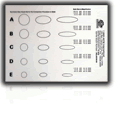Potřebujeme váš souhlas k využití jednotlivých dat, aby se vám mimo jiné mohly ukazovat informace týkající se vašich zájmů. Souhlas udělíte kliknutím na tlačítko „OK“.
ASTM E930-18
Standard Test Methods for Estimating the Largest Grain Observed in a Metallographic Section (ALA Grain Size)
Přeložit název
NORMA vydána dne 1.12.2018
Informace o normě:
Označení normy: ASTM E930-18
Datum vydání normy: 1.12.2018
Kód zboží: NS-936581
Počet stran: 6
Přibližná hmotnost: 18 g (0.04 liber)
Země: Americká technická norma
Kategorie: Technické normy ASTM
Kategorie - podobné normy:
Anotace textu normy ASTM E930-18 :
Keywords:
ALA grain, caliper diameter, comparison procedure, ellipse measurement, grain size, largest grain, measuring procedure, metallography, microstructure, outlier grain, point-count procedure,, ICS Number Code 19.120 (Particle size analysis. Sieving)
K této normě náleží tyto doplňky:
Adjunct to E930 Test Methods for Estimating the Largest Grain Observed in a Metallographic Section (ALA Grain Size)
Vybrané provedení:Zobrazit všechny technické informace
Doplňující informace
| Significance and Use | ||||||||||||
|
4.1 The presence of large grains has been correlated with anomalous mechanical behavior in, for example, crack initiation, crack propagation, and fatigue. Thus there is engineering justification for reporting the ALA grain size. 4.2 These methods shall only be used with the presence of outlier coarse grains, 3 or more ASTM grain size numbers larger than the rest of the microstructure and comprising 5 % or less of the specimen area. A typical example is shown in Annex A1 as Fig. A1.1. 4.3 These methods shall not be used for the determination of average grain size, which is treated in Test Methods E112. Examples of microstructures that do not qualify for ALA treatment are shown in Annex A1 as Fig. A1.2, Fig. A1.3, and Fig. A1.4. 4.4 These methods may be applied in the characterization of duplex grain sizes, as instructed in the procedures for Test Methods E1181. |
||||||||||||
| 1. Scope | ||||||||||||
|
1.1 These test methods describe simple manual procedures for measuring the size of the largest grain cross-section observed on a metallographically prepared plane section. 1.2 These test methods shall only be valid for microstructures containing outlier coarse grains, where their population is too sparse for grain size determination by Test Methods E112. 1.3 This standard does not purport to address all of the safety concerns, if any, associated with its use. It is the responsibility of the user of this standard to establish appropriate safety, health, and environmental practices and determine the applicability of regulatory limitations prior to use. 1.4 This international standard was developed in accordance with internationally recognized principles on standardization established in the Decision on Principles for the Development of International Standards, Guides and Recommendations issued by the World Trade Organization Technical Barriers to Trade (TBT) Committee. |
||||||||||||
| 2. Referenced Documents | ||||||||||||
|
Doporučujeme:
Aktualizace technických norem
Chcete mít jistotu, že používáte pouze platné technické normy?
Nabízíme Vám řešení, které Vám zajistí měsíční přehled o aktuálnosti norem, které používáte.
Chcete vědět více informací? Podívejte se na tuto stránku.





 Cookies
Cookies
